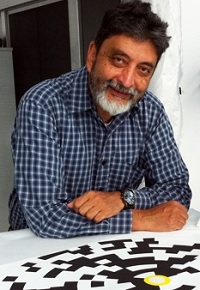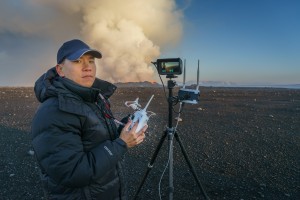2015
2015 Keynotes updated as information is received.
M.V. Srinivasan (University of Queensland)
Vision and Navigation in Honeybees and Applications to Robotics (Abstract)
Srinivasan is presently Professor of Visual Neuroscience at the Queensland Brain Institute and the School of Information Technology and Electrical Engineering of The University of Queensland.
He holds an undergraduate degree in Electrical Engineering from Bangalore University, a Master’s degree in Electronics from the Indian Institute of Science, a Ph.D. in Engineering and Applied Science from Yale University, a D.Sc. in Neuroethology from the Australian National University, and an Honorary Doctorate from the University of Zurich.
Among his awards and honours are Fellowships of the Australian Academy of Science, of the Royal Society of London, and of the Academy of Sciences for the Developing World, an Inaugural Federation Fellowship, the 2006 Australia Prime Minister’s Science Prize, the 2008 U.K. Rank Prize for Optoelectronics, and the 2009 Distinguished Alumni Award of the Indian Institute of Science, and the Membership of the Order of Australia (AM) in 2012.
Eric Cheng (DJI)
From Waves to Wind: Natural History Imaging Using Underwater Cameras and Drones (Abstract)
Eric Cheng is an award-winning photographer and the Director of Aerial Imaging at DJI, the makers of the popular Phantom aerial-imaging quadcopter. Throughout his career, Eric has straddled his passion for photography, entrepreneurship, technology and communication. He publishes Wetpixel.com, the leading underwater-photography community on the web, and writes about his aerial-imaging pursuits at skypixel.org His photography has been featured at the Smithsonian’s Natural History Museum and in many media outlets including Wired, Outdoor Photographer, Popular Photography, Washington Post, Wall Street Journal, Make, Photography Week, ABC, CBS, and CNN.
Caught between technical and creative interests, Cheng holds bachelor’s and master’s degrees in computer science from Stanford University, where he also studied classical cello performance. Eric leads regular photography expeditions and workshops around the world, and has given seminars and lectures internationally at events including TEDx, the Churchill Club, Photoshelter Luminance, CES, SXSW, AsiaD, DEMA, and others. Previously, Eric worked as Director of Photography at Lytro, the light-field camera company.
Wolfgang Heidrich
Imaging Light in Flight and Other Uses for TOF Cameras (Abstract)
Prof. Wolfgang Heidrich is the director of the Visual Computing Center at King Abdullah University of Science and Technology (KAUST). He is also affiliated with the University of British Columbia, where he held the Dolby Research Chair until 2013. Dr. Heidrich received his PhD in Computer Science from the University of Erlangen in 1999, and then worked as a Research Associate in the Computer Graphics Group of the Max-Planck-Institute for Computer Science in Saarbrucken, Germany, before joining UBC in 2000. Dr. Heidrich’s research interests lie at the intersection of computer graphics, computer vision, imaging, and optics. In particular, he has worked on computational photography and displays, High Dynamic Range imaging and display, image-based modeling, measuring, and rendering, geometry acquisition, GPU-based rendering, and global illumination. Dr. Heidrich has written well over 150 refereed publications on these subjects and has served on numerous program committees. His work on High Dynamic Range Displays served as the basis for the technology behind Brightside Technologies, which was acquired by Dolby in 2007. Dr. Heidrich is the recipient of a 2014 Humboldt Research Award.
Rebecca Richards-Kortum (Rice University)
Using Optical Technologies to Develop Point-of-Care Diagnostics for Low-Resource Settings
Prof. Rebecca Richards-Kortum is the Stanley C. Moore Professor of Bioengineering and Professor of Electrical and Computer Engineering at Rice University, the Founder of Beyond Traditional Borders, and the Director of Rice 360°: Institute for Global Health Technology. She focuses on translating research that integrates advances in nanotechnology and molecular imaging with microfabrication technologies to develop optical imaging systems that are inexpensive, portable, and provide point-of-care diagnosis. This basic and translational research is highly collaborative and has led to new technologies to improve the early detection of cancers and other diseases, especially in impoverished settings.
Microelectromechanical systems (MEMS) use micro-scale technology to design low-cost, reusable platforms for point-of-care (POC) diagnostics. When used with contrast agents, these rugged and portable optical imaging systems detect molecular signatures of pre-cancer, assess tumor margins, and monitor a patient’s response to therapy. Current systems are being tested and applied through multidisciplinary collaborations with clinicians and researchers at Rice, the UT M.D. Anderson Cancer Center, UT Health Science Center-Houston, UT at Austin, the University of Arizona, and the British Columbia Cancer Agency. Over the past few years, Dr. Richards-Kortum and collaborators have translated these technologies from North America to both low- and medium-resource developing countries (Botswana, India, Taiwan, Mexico, and Brazil).
Past ICCP Keynote Speakers:
2014
David Brady (Duke) – The System Camera and its Future
Emmanuel Candes (Stanford) – Phase Retrieval: Old and New
Joseph Ford (UCSD) – Computational Fiber-Coupled Imaging
2013
Edward H. Adelson (MIT) – Living in Shadeworld
Nader Engheta (University of Pennsylvania) – Seeing the Unseen: From Polarization-sensitive Eyes in Nature to Man-made Polarization Cameras
Hany Farid (Dartmouth College) – Photo Forensics
Marc Levoy (Stanford University) – What Google Glass Means for the Future of Photography
Austin Roorda (University of California, Berkeley) – How the Eye Sees a Stable and Moving World
J. Kim Vandiver (MIT) – Stopping Time: The life work of Prof. Harold “Doc” Edgerton
2012
Kurt Akeley (Lytro Inc.) – A different perspective on the Lytro light field camera
Steven Bathiche (Microsoft Corporation) – Breaking Harlow’s Monkeys
David Brady (Duke University) – Physical layer compression for high pixel count imaging
Roger Hanlon (Marine Biological Laboratory) – Rapid Adaptive Camouflage in Cephalopods
Shree Nayar (Columbia University) – Focal Sweep Photography
Jason Salavon (University of Chicago) – Artist’s Talk: On Recent Work and the Malleable Visual
Steve Seitz (University of Washington and Google Inc.) – A Trillion Photos
2011
Illah R. Nourbakhsh (CMU) – Gigapixel Imaging for Science
Lihong V. Wang (WashU) – Photoacoustic Tomography: Ultrasonically Breaking through the Optical Diffusion Limit
Ed Dowski (CDM Optics) – A New Paradigm for Future Application-Specific Imaging Systems
2010
Jerry Nelson – Building the world’s biggest telescope
Gary Settles – The art & science of Schlieren photography





